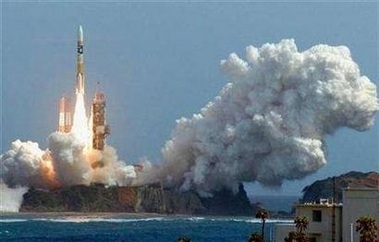Japan plans to launch its first mission to land a spacecraft on the moon in the next decade, officials said Tuesday, joining China and India in a race among Asian nations to explore the lunar surface.

The rocket carrying the three-tonne SELENE orbiter is pictured blasting off from the island of Tanegashima, about 1,000 km (620 miles) south of Tokyo, on September 14, 2007. Japan plans to launch its first mission to land a spacecraft on the moon in the next decade, officials said on Tuesday, joining China and India in a race among Asian nations to explore the lunar surface. [Agencies] |
Japan's first lunar orbiter is currently circling the moon, and the country is racing with China and India to land a craft on the lunar surface - a feat so far achieved only by the former Soviet Union and the United States.
"We are aiming to carry out the project in the middle of the 2010s. It will examine geological features of the moon as well as natural resources available there," said an official from the Japan Aerospace Exploration Agency.
The Soviet Union was the first to achieve a soft landing on the moon, in 1966. So far, only the United States has landed a manned craft, during its Apollo program. It plans a new lunar orbiter next year and is working on a permanent lunar station.
China plans to launch a moon orbiter this year and land a craft on the surface in 2010. India plans an orbiter next year and a manned mission to the moon by 2020.
Japan's first explorer to land on the moon will consist of an unmanned lander, a lunar rover equipped with robotic arms and a data-relay satellite, Japanese space agency officials said.
The project was expected to cost about $470 million, they said, similar to the cost of the current orbiter.
Japan crashed a craft into the moon in 1990, but its first full lunar explorer - officially titled SELENE but nicknamed Kaguya, after a folktale princess - began orbiting the moon last week.
The mission has a main orbiter and two baby satellites equipped with 14 observation instruments designed to examine surface terrain, gravity and other features for clues on the origin and evolution of the moon. It will orbit the moon for about a year until it runs out of fuel.
The Japanese space agency has said it hopes to send astronauts to the moon by 2025, although Japan has not yet attempted manned space flight.
Japan's space program was in tatters in the late 1990s after two unsuccessful launches of a previous rocket, the H-2.
Disaster followed in 2003 when Japan had to destroy an H-2A rocket carrying two spy satellites minutes after launch as it veered off course.
